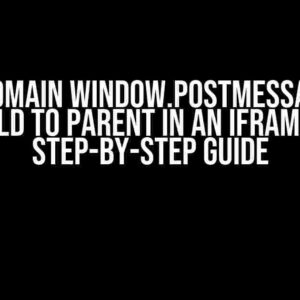If you’re reading this, chances are you’ve stumbled upon the infamous “Unknown Bayeux Transport” error while trying to set up CometD 8.0.2 with WebSocket. Fear not, dear developer, for you’re about to embark on a journey to debug and conquer this pesky issue. In this article, we’ll delve into the world of CometD, WebSocket, and Bayeux transports, and provide you with clear, step-by-step instructions to resolve the error and get your real-time web application up and running.
What is CometD?
CometD is a popular, open-source implementation of the Bayeux protocol, which enables real-time communication between web servers and clients. It provides a scalable, flexible, and reliable way to push data from the server to connected clients, making it an essential tool for building real-time web applications.
What is Bayeux?
Bayeux is a protocol that allows web servers to push data to connected clients in real-time, enabling bidirectional communication between the server and the client. Bayeux is designed to work over HTTP and WebSocket transports, making it a versatile protocol for web development.
The “Unknown Bayeux Transport” Error
The “Unknown Bayeux Transport” error occurs when CometD is unable to establish a connection with the Bayeux server using the specified transport. This error typically appears when CometD is configured to use WebSocket as the transport, but the WebSocket connection is not properly established.
Here’s an example of the error message you might see in your browser console:
CometD Error: Unknown Bayeux transport: undefined
at CometD._connect (http://example.com/cometd.js:1234)
at CometD.init (http://example.com/cometd.js:567)
at new CometD (http://example.com/cometd.js:901)Debugging the Error
Before we dive into the solution, let’s take a step back and troubleshoot the issue. Follow these steps to identify the root cause of the error:
-
Check the CometD configuration: Verify that the CometD configuration is correct, and the WebSocket transport is enabled.
-
Verify WebSocket support: Ensure that the server and client support WebSocket connections.
-
Inspect the network traffic: Use your browser’s developer tools to inspect the network traffic and verify that the WebSocket connection is being established.
-
Check for firewall or proxy issues: If you’re behind a firewall or proxy, ensure that WebSocket connections are not being blocked.
Resolving the “Unknown Bayeux Transport” Error
Now that we’ve identified the potential causes of the error, let’s walk through the steps to resolve it:
Step 1: Enable WebSocket Transport in CometD
In your CometD configuration, ensure that the WebSocket transport is enabled by adding the following code:
var cometd = new CometD();
cometd.configure({
url: '/cometd',
logLevel: 'debug',
transports: ['websocket', 'long-polling']
});Step 2: Verify WebSocket Support on the Server
Ensure that your server supports WebSocket connections. If you’re using a Java-based server, you can use the Jetty WebSocket API or the Tomcat WebSocket API.
For example, in Jetty, you can enable WebSocket support by adding the following code:
import org.eclipse.jetty.websocket.server.WebSocketHandler;
import org.eclipse.jetty.websocket.servlet.WebSocketServletFactory;
// ...
Server server = new Server(8080);
WebSocketHandler handler = new WebSocketHandler();
handler.setServletFactory(new WebSocketServletFactory());
server.setHandler(handler);
server.start();Step 3: Verify WebSocket Support on the Client
On the client-side, ensure that the WebSocket API is supported in your browser. You can use the following code to check for WebSocket support:
if ('WebSocket' in window) {
console.log('WebSocket is supported!');
} else {
console.log('WebSocket is not supported!');
}Step 4: Establish a WebSocket Connection
Once you’ve verified WebSocket support on both the server and client, establish a WebSocket connection using the following code:
var socket = new WebSocket('ws://example.com/cometd');
socket.onopen = function() {
console.log('WebSocket connection established!');
};
socket.onmessage = function(event) {
console.log('Received message from server:', event.data);
};
socket.onclose = function() {
console.log('WebSocket connection closed!');
};
socket.onerror = function(error) {
console.log('WebSocket error occurred:', error);
};Step 5: Initialize CometD with WebSocket Transport
Finally, initialize CometD with the WebSocket transport using the following code:
var cometd = new CometD();
cometd.configure({
url: '/cometd',
logLevel: 'debug',
transports: ['websocket']
});
cometd.handshake();Conclusion
And there you have it! By following these steps, you should be able to resolve the “Unknown Bayeux Transport” error with CometD 8.0.2 and WebSocket. Remember to debug the error, enable WebSocket transport in CometD, verify WebSocket support on the server and client, establish a WebSocket connection, and initialize CometD with the WebSocket transport.
If you’re still experiencing issues, feel free to leave a comment below, and we’ll do our best to help you troubleshoot the problem.
Happy coding, and don’t let the “Unknown Bayeux Transport” error hold you back from building amazing real-time web applications!
| CometD Version | WebSocket Transport | Bayeux Protocol |
|---|---|---|
| 8.0.2 | Enabled | Supported |
- You can download the CometD 8.0.2 library from the official CometD website.
- For more information on Bayeux, visit the Bayeux Protocol website.
- WebSocket is a W3C standard, and you can learn more about it on the WebSocket API website.
Frequently Asked Question
CometD via WebSocket got you down? Worry not, friend! We’ve got the scoop on “unknown Bayeux transport” with CometD 8.0.2.
What’s the deal with “unknown Bayeux transport” error in CometD 8.0.2?
This error is usually caused by a mismatch between the Bayeux transport configured on the server-side and the one used by the client-side. Make sure you’re using the correct transport (in this case, WebSocket) on both ends!
How do I configure CometD to use WebSocket transport?
You can configure CometD to use WebSocket transport by setting the `transport` parameter to `websocket` in your CometD JavaScript configuration. For example: `var cometd = new org.cometd.CometD(); cometd.configure({ url: ‘/cometd’, transport: ‘websocket’ });`
Do I need to enable WebSocket on my server for CometD to work?
Yes, you need to enable WebSocket on your server for CometD to work with WebSocket transport. This usually involves configuring your server to support WebSocket connections. Check your server documentation for specific instructions!
Can I use CometD 8.0.2 with older browsers that don’t support WebSocket?
While CometD 8.0.2 supports WebSocket, it also provides fallback transports for older browsers. You can configure CometD to use long-polling or JSONP as fallback transports if WebSocket is not available. This way, you can ensure compatibility with older browsers!
Where can I find more information about CometD and WebSocket?
You can find more information about CometD and WebSocket in the official CometD documentation, as well as in various online resources and tutorials. Additionally, you can explore the CometD GitHub repository for code samples and examples!





